Abstract
In society, there are preconceived ideas that the girls are not as talented like boys in the area of natural sciences, technologies, engineering and math – STEM education. Despite the fact that girls perform similarly to boys in all countries, there is a tendency to underestimate girls' performance compared to boys. The paper presents the school results of students by real path to the natural sciences, technology, engineering and math disciplines to the moment of graduating. This research aims to analyse, according to the students' gender, the school results to the real disciplines - mathematics, physics, chemistry, biology and informatics. The study was conducted in two stages; the first stage consisted in analysing the results to the STEM disciplines: 60 students in the 9th, 11th and 12th grades, in the years 2015-2016. The study extended to graduates from baccalaureate in 2017, from profile of mathematics-IT and the profile of natural science. The number of students analysed was 400, 200 of those at the top of the rankings and 200 of those promoted in the rank queue, with scores higher than 6. The hypothesis that starts is that the girls have weaker results in the field of accurate sciences. As a result of the study, the hypothesis is denied because more girls obtained good grades compared to boys for the 2017 baccalaureate exam.
Keywords: GirlsboysassessmentSTEM educationgender differences in educationsocial perception
Introduction
In society, there are preconceived ideas that the girls are not as talented like boys in the area of STEM sciences. On the other hand, according to the study "Gender Differences and Their Effects on School Outcomes: A Study of the Measures Taken So far and the Current Situation in Europe", conducted by the European Commission through Eurydice, published in 2009, they are small differences between the results in science field and the gender of students. Despite the fact that girls perform similarly to boys in all countries, there is a tendency to underestimate girls' performance compared to boys. As a result, boys will generally choose professions or careers identified as "characteristic to boys," while girls will opt for professions or careers identified as "characteristic to girls". Depending on the subject areas - maths, physics or natural sciences and, depending on the age of students, international student assessment surveys can produce different reports on identified gender profiles. TIMSS studies have often revealed gaps in favour of boys, while PISA reported that there are generally no significant differences between competencies of girls and boys (European Parliament, 2015).
Genders' role is defined as a set of expectations that provide behavioural prescriptions for women and men. The gender stereotype is defined as a set of social or cultural prescriptions of gender roles (Petrovai, & Bursuc, 2004). Also, in the online article “Women in the History of Europe”, we find that “There were many pseudoscientific theories which arose which tried to demonstrate the physical or intellectual inferiority of women” (Ballarin, 1996-1998).
Differences in the cognitive abilities of girls and boys explain the different needs in their learning process. Cognitive skills are the set of processes involved in information processing (reasoning, memorization, attention, use of language, etc.). From a classical perspective of cognitive differences between genres, Maccoby and Jacklin (1974) publishes a study-synthesis on research into girls and boys and identifies three cognitive abilities as the differences between them: verbal skills, quantitative abilities and computational (mathematical) and visual-spatial abilities. The research concludes that the boys have mathematical and visual-space skills better than girls and the girls have superior verbal skills.
Verbal and mathematical skills differentiate boys and girls only as further acquisitions and are not prerequisites for starting in individual development. How to use and adequately capitalize on cognitive differences in the learning process can equalize the boys-to-male difference in mathematical and verbal skills (Santrock, 2001).
In the opinions of some researchers (Gurian, 2010; Halpern, 1992, Halpern & Wright 2002), the cognitive aspects that mark gender differences in learning are represented in the following areas: deductive / inductive reasoning, abstract / concrete reasoning, language use, space and movement use), the use of symbolism, the advantages of group learning, self-evaluation of performance or motor skills. In terms of deductive / inductive reasoning, (Gurian, 2010), boys would have a deductive thinking, using the general principle in individual situations, while girls have a kind of inductive thinking; they start from concrete examples, on which they generalize. Similarly, boys would have superior abilities to girls in terms of abstraction, aspect with implications for facilitating the development of math abilities for girls.
Nevertheless, in many countries, boys have a tendency to achieve lower school performance than girls, a trend that is accentuated when students promote in upper secondary education and is less visible in the lower secondary cycle. Boys are more likely to drop out of school before obtaining a higher secondary education diploma compared to girls (see Figure

It should be underlined that mixed education has a tradition of up to 60 years, and the wide access of girls to education is relatively young (end of 19th century - start of the 20th century)
Problem Statement
The study was conducted in two stages; the first stage consisted in analysing the results to the STEM disciplines: 60 students in the 9th, 11th and 12th grades, 20 persons in every classroom, in the school year 2015-2016. The study extended to graduates from baccalaureate in 2017, from profile of mathematics-IT and the profile of natural science. The number of students analysed was 400, 200 of those at the top of the rankings and 200 of those promoted in the rank queue, with scores higher than 6.
The hypothesis that starts is that the girls have weaker results in the field of accurate sciences.
Research Questions
The research answers to the question whether boys are better than girls to the real disciplines or not. It should be investigated the social causes that generate the perception that girls are less intellectually endowed to the exact disciplines, how is myth or reality.
Purpose of the Study
This research aims to analyse, according to the students' gender, the school results to the real disciplines - mathematics, physics, chemistry, biology and informatics.
Research Methods
The research is based to two statistics:
The first is made with 60 students in a high school, 25 boys and 35 girls, and
The second use http://static.bacalaureat.edu.ro/2017/rapoarte/rezultate/index.html, the official site of Romanian exam of baccalaureate. For the mathematics-computer science and the natural sciences profiles was extracted following data about candidates: gender, county and the passing note the baccalaureate exam
Findings
The findings of research are present according to the final marks at the end of the school year 2015 -2016 and the results of baccalaureate exam 2017 for real profile.
Results and discussion about the final marks at the end of the school year, according to enre
The student outcomes at the end of the school year 2015 – 2016 are presented on Figure
Girls’ achievements are higher than those of the boys for all considered subject. The difference between girls’ and boys' results is 1.27 point to math; 0,64 point to physics; 1.13 to chemistry, 0.87 point to biology and the smaller, 0.39 point to computer science, all in favour of girls. (figure
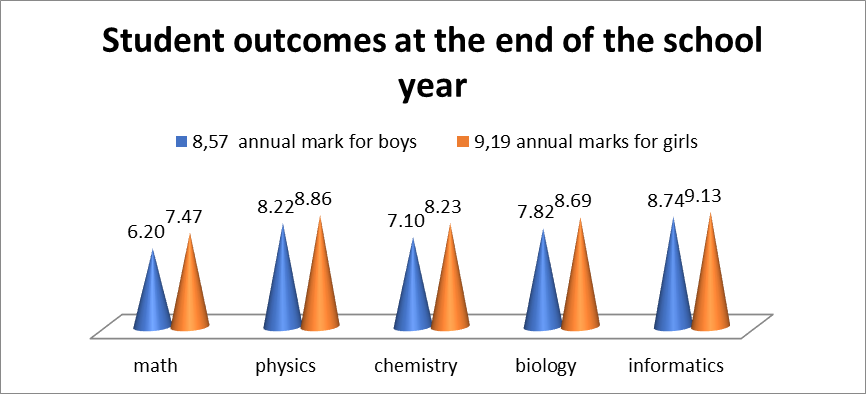
Results of baccalaureate 2017 for real profile, function of gender
It was take into account 400 students, 200 for each category:
on top of ranking 151 girls and 49 boys, first with marks between 10 and 9.93;
on down of ranking 66 girls and 134 boys, the last that have passed the exam, with scores ranging from 6.03 to 6.
The distribution by gender is approximatively equal, 183 boys respectively 46% percent and 217 girls, which mean 54% percent.
The distribution by profile, according to table
Distribution by gender of the first 200 candidates to the front of list, reveal that 75% are girls and 25% are boys. Distribution of the last 200 candidates to the bottom of ranking, and which passed the baccalaureate exam, show that 33% are girls and 67% are boys. (Figure
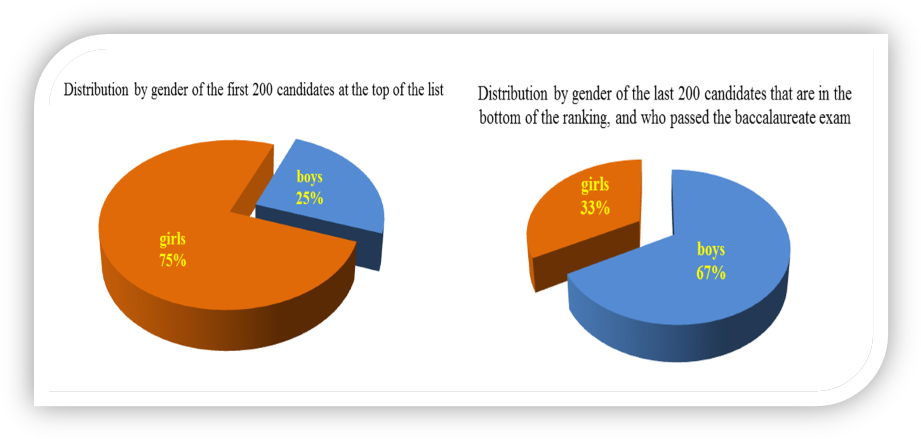
If the research is reported to all 400 students take into account, 218 girls and 182 boys, results show on top 37,75% girls and 12,25% boys; the report are reversed to bottom, where 16,50% are girls and 33,50% are boys. (Figure
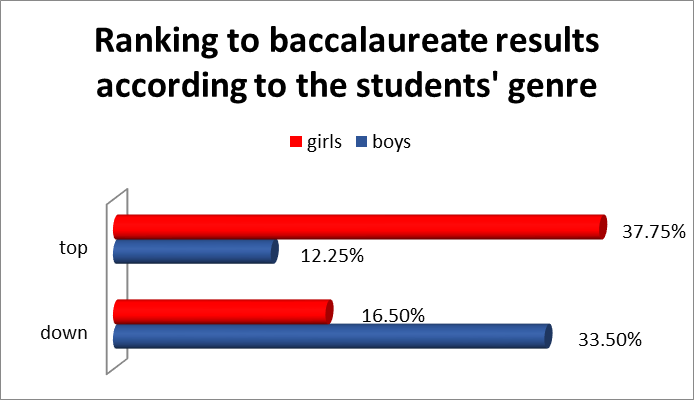
The average of the results obtained for the 400 candidates is 7.99. The average of girls results is 8.76, while for boys have 7.07.
The results by profile show on top are more girls than boys for both profiles (table
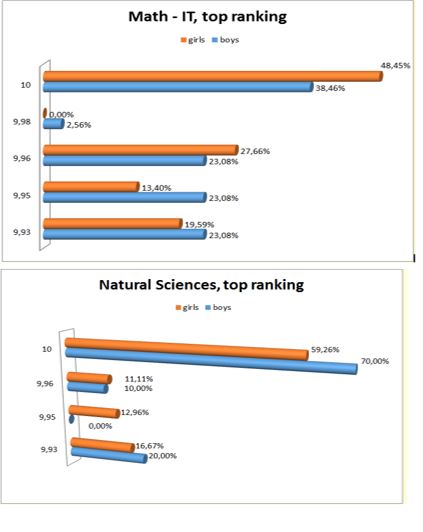
On down list of baccalaureate exam are more boys than girls (table
Reporting has been made to the number of girls or boys who have achieved a certain note. Thus, the boys to the Math - IT profile, situated at the bottom of the table have obtained: 21.18% - the note 6.03; 1.18% - the note 6.02-; 38.82% - the note 6,01 and 38.82% - the note 6. To Natural Sciences profile, more girls than boys obtained the note 6 – 48,39% versus 34,69% (Figure
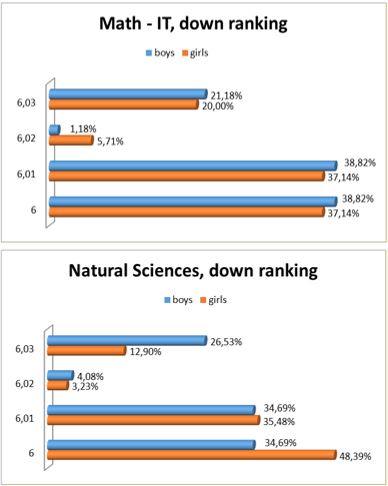
Conclusion
As a result of the study, the hypothesis is denied because more girls obtained good grades compared to boys into both research: the one about the school year 2015 – 2016 and the other on the 2017 baccalaureate exam.
In the school year 2015 – 2016, the boys' achievements are lesser than those of the girls for all considered subject. More that, the annual mark for boys are 8,57 and for girls are 9,19 (figure
The research on the baccalaureate exam in 2017 comes to reinforce the results obtained in the first, meaning that more girls have good results than boys.
The research does not address the cognitive skills of the two categories of subjects, but refer only to their school results.
References
- Ballarin, P., Birriel, Margarita M., Martinez, C., Ortíz, T. (1996-1998). Women in the History of Europe, 1.3 Education and gender models in Europe. Proyecto Erasmus Miniguide 2 Pilot Projet. Européan Módule nº 26394-MG2-1-96-1-ES-ERASMUS-EEM, WOMEN IN THE EUROPEAN UNIÓN. Retrieved from http://www.helsinki.fi/science/xantippa/wee/weetext/wee213.html, https://www.ugr.es/~ballarin/public/uploads/cv_pilar_ballarin.pdf
- European Commission, EACEA P9 EURYDICE. (2009). Gender Differences in Educational Outcomes: Study on the Measures Taken and the Current Situation in Europa. Retrieved from https://www.west-info.eu/the-school-and-the-gender-gap/gender-differences-in-education/;
- European Parliament. (2015). Women and education in the EU. Briefing INFOGRAPHIC - March 2015, Retrived from http://www.europarl.europa.eu/RegData/etudes/ATAG/2015/551301/EPRS_ATA(2015)551301_EN.pdf
- Gurian, M., Stevens, K. (2010) Boys And Girls Learn Differently! A guide for teachers and parents. Retrieved from https://books.google.ro/books?id=o_WclCNMBm4C&pg=PR8&lpg=PR8&dq=deductive+/+inductive+reasoning,+abstract+/+concrete+reasoning,+language+use,+space+and+movement+use,+gurian&source=bl&ots=0qMnM1oXPg&sig=qyFr2hGEDJ6WVUKpcS6eDG5VvrQ&hl=fr&sa=X&ved=2ahUKEwi4vLqWj5LeAhWMk4sKHSpcASgQ6AEwA3oECAYQAQ#v=onepage&q&f=false
- Halpern, D. F. (1992) Sex differences in cognitive abilities. Hillsdale, NJ: Lawrence Erlbaum Associates.
- Halpern, Diane F., Wright, Tiffany M. (2002) A process-oriented model of cognitive sex differences. Learning and Individual Differences, 8, Issue 1, 1996, 3-24, Retrieved from. https://www.sciencedirect.com/science/article/pii/S1041608096900035?via%3Dihub
- Maccoby, E. E., Jacklin, C. N. (1974). The psychology of sex differences. Stanford, CA: Stanford University Press.
- Petrovai, D., Bursuc, B., (coord.), Anca R., Tătaru, R., Calenic, D. (2004, Diferențe de gen în creșterea și educarea copiilor. Centrul Parteneriat pentru Egalitate, Editor.ro, Retrieved from http://www.cpe.ro/wp-content/uploads/2016/03/Diferente-de-gen-in-cresterea-si-educarea-copiilor.pdf
- Portal SEI, Bacalaureat (2017). Retrieved from http://static.bacalaureat.edu.ro/2017/rapoarte/rezultate/index.html
Copyright information

This work is licensed under a Creative Commons Attribution-NonCommercial-NoDerivatives 4.0 International License.
About this article
Publication Date
15 August 2019
Article Doi
eBook ISBN
978-1-80296-066-2
Publisher
Future Academy
Volume
67
Print ISBN (optional)
-
Edition Number
1st Edition
Pages
1-2235
Subjects
Educational strategies,teacher education, educational policy, organization of education, management of education, teacher training
Cite this article as:
Bostan*, C. –. G. (2019). Analysis Between Students Genre And Their School Results To Real Disciplines. In E. Soare, & C. Langa (Eds.), Education Facing Contemporary World Issues, vol 67. European Proceedings of Social and Behavioural Sciences (pp. 798-805). Future Academy. https://doi.org/10.15405/epsbs.2019.08.03.95
